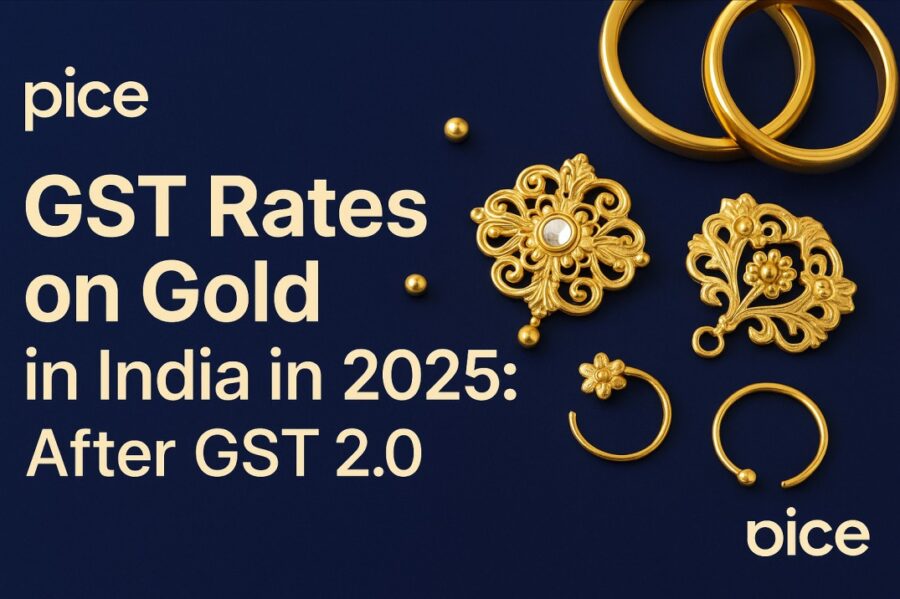GST Rates on Gold in India in 2025: After GST 2.0
- 16 Aug 24
- 8 mins

GST Rates on Gold in India in 2025: After GST 2.0
- GST on Gold: An Overview
- Historical Taxation vs. GST: How Gold Taxation Has Evolved
- GST Rates on Gold and Related Items
- Current GST Rates on Gold and Gold Jewellery in India
- Recent Changes in GST Rates on Gold:
- What’s New?
- Impact of GST Rate Changes on Gold
- Prices and the Market
- GST on Gold: Implications for Investors and Jewellery Buyers
- GST Compliance for Jewellers and Traders
- Conclusion
Key Takeaways
- GST on gold is 3%, with 5% on jewellery-making charges.
- GST replaced VAT and excise, simplifying gold taxation.
- Gold jewellery, bars, and coins all attract 3% GST.
- GST changes affect gold prices and consumer demand.
- Jewellers must comply with GST for transparency and credit claims.
Understanding the GST rates on gold is crucial for investors and jewellery buyers in India. The Goods and Services Tax (GST) has streamlined gold taxation, impacting pricing and demand.
Since its introduction in 2017, GST has replaced various taxes, creating a unified tax structure. This change has brought transparency and simplicity to gold transactions.
The current GST rate on gold is 3%, with an additional 5% on making charges for jewellery. These rates are periodically reviewed by the GST Council, affecting the gold market and investment.
strategies.
Recent changes in GST rates can influence gold's appeal as a safe investment. Staying informed about thechanges is essential for making sound financial decisions.
GST on Gold: An Overview
The Goods and Services Tax (GST) was introduced in India on July 1, 2017. It revolutionized the taxation system for goods like gold. Before GST, the taxation was complex, involving multiple layers such as VAT, excise duty, and customs duty.
Under the GST system, gold is taxed at a flat rate of 3%. This change aimed to simplify gold taxation and establish a unified framework. Prior to GST, each state had different tax rates, leading to a complicated system.
The GST on gold applies to both domestic and imported gold. This is crucial for maintaining a level playing field in the gold market. Additionally, the GST system includes charges on the making of jewelry.
Historical Taxation vs. GST: How Gold Taxation Has Evolved
Gold has always been a prominent part of the Indian economy. Before GST, taxation on gold was multifaceted, consisting of a patchwork of state taxes. Various charges such as VAT, excise duty, and local levies added to the complexity.
These older taxes made the process intricate for traders and consumers alike. The VAT rates on gold varied from state to state, leading to pricing discrepancies. Additionally, excise duties were often unclear and inconsistently applied.
With GST, the government aimed to dismantle this convoluted system. The creation of a flat and uniform tax rate brought much needed clarity. Simplifying tax structures also reduced the incidence of tax evasion.
GST Rates on Gold and Related Items
The GST Council has set different rates for gold and precious stones depending on their classification under HSN (Harmonised System of Nomenclature) codes. The details are as follows:
| Particulars | HSN Code | GST Rate |
|---|---|---|
| Precious stones (other than diamonds) and semi-precious stones, whether or not worked or graded but not strung, mounted or set | 7103, 7104 | 0.25% |
| Ungraded precious stones (other than diamonds) and semi-precious stones, temporarily strung for transport (including synthetic or reconstructed stones) | 7103, 7104 | 0.25% |
| Diamond, gold, pearls, silver, or jewellery of gold/silver (including synthetic or reconstructed stones, unworked or roughly shaped) | 7101, 7102, 7106, 7107, 7108, 7109, 7111, 7113, 7114, 7116, 7118 | 3% |
| Job work in relation to cut and polished diamonds, plain or studded jewellery of gold, silver, etc. | 9988 | 1.5% |
Current GST Rates on Gold and Gold Jewellery in India
GST on gold in India stands at 3%. This rate applies to both raw gold and gold jewellery, ensuring uniform taxation. The GST is calculated on the value of the gold along with any applicable making charges.
Gold jewellery attracts an additional charge. A 5% GST rate on the gold jewellery-making charges is levied. This makes the total GST applicable on crafted jewellery higher.
The uniform tax rate of GST has simplified the process. Unlike older taxes, GST is straightforward and transparent. This helps consumers understand how much they pay in taxes when buying gold.
| Type of Gold / Investment | GST Rate | Details |
|---|---|---|
| 24 Carat Gold | 3% | Applies to pure gold in bars, coins, and bullion. |
| 22 Carat Gold | 3% | Applies to gold jewellery, coins, and ornaments. |
| Making Charges (Jewellery) | 5% | GST on labour or design work for gold ornaments. |
| Digital Gold | 3% | Same rate as physical gold purchased online. |
| Gold ETFs / SGBs / Mutual Funds | 18% (on services) | GST applies only to management or service fees. |
GST on Gold Bars, Coins, and Digital Gold
Gold bars and coins come under the same GST slab as raw gold. The rate remains 3%, whether purchasing for investment or personal collection. This uniformity aids in pricing clarity across various forms of gold.
Digital gold, an emerging investment trend, is also taxed at 3%. Although it doesn't involve physical possession, it falls under the same GST guidelines. This consistency provides a seamless investment experience for tech-savvy investors.
GST on Making Charges for Gold Jewellery
Gold jewellery involves additional craftsmanship, leading to making charges. The GST on these charges is set at 5%. This means that both the gold value and labour cost are duly taxed.
These taxes affect the final price consumers pay for jewellery. Understanding the making charges helps in calculating the overall cost. Consumers often seek clarity on this additional charge when buying jewellery.
Recent Changes in GST Rates on Gold:
What’s New?
In recent discussions, the GST Council has deliberated on revising GST rates for gold. Although the core rate of 3% remains unchanged, proposals for alteration were considered. Industry experts often scrutinize these meetings closely as changes can ripple through the market.
The last significant update occurred in 2017 when GST replaced multiple taxes. Recent conversations focus on streamlining processes and adjusting auxiliary charges.
Such refinements aim to ensure smoother transactions and greater transparency for consumers.
Impact of GST Rate Changes on Gold
Prices and the Market
GST rate changes can significantly impact gold prices, affecting both jewelers and consumers. Even minor adjustments in GST rates can alter the gold market landscape, influencing pricing strategies and consumer behavior.
When GST rates increase, the cost of gold and gold jewellery tends to rise. This rise can dampen demand, particularly among price-sensitive buyers. Conversely, if GST rates decrease, consumers may perceive better value, potentially boosting sales.
Before GST, gold was taxed under multiple levies — 1% excise duty, 1% VAT, and 10% customs duty (for imported gold). After GST, these were replaced by a 3% flat GST rate, making the tax structure simpler and more transparent.
However, GST increased the overall cost of gold jewellery for consumers since the tax now applies to both the value of gold and the making charges. For example:
If a gold necklace costs ₹1,00,000 with ₹10,000 as making charges,
- GST on gold value = ₹1,00,000 × 3% = ₹3,000
- GST on making charges = ₹10,000 × 5% = ₹500
Total payable GST = ₹3,500, increasing the final price to ₹1,13,500.
GST on Gold: Implications for Investors and Jewellery Buyers
Understanding GST implications is crucial for both investors and jewellery buyers. GST rates directly influence the cost-benefit analysis of gold investments.
For investors, the GST rate on gold serves as a critical factor in evaluating potential returns. Higher rates may reduce profit margins, making gold less attractive. Conversely, favorable GST rates can enhance gold's appeal as a safe investment.
Jewellery buyers experience a different set of implications. GST rates affect the final price of gold jewellery,including making charges. Buyers should be aware of these rates to make informed purchasing decisions.
GST Compliance for Jewellers and Traders
GST compliance is mandatory for jewelers and traders in India. Adhering to GST regulations ensures smooth business operations and legal compliance.
Jewellers must register under GST and file regular returns. This includes maintaining precise records of sales, making charges, and other taxable elements.
For traders, understanding input tax credit is crucial. This allows them to claim credits on taxes paid during gold purchases.
Conclusion
The introduction of GST on gold has brought about significant changes to the jewellery market in India. While the initial impact included a hike in prices, the long-term benefits include greater transparency and a more regulated market.
💡Missing the deadline to pay GST payments? Download Pice and start using a credit card to pay GST on time, experience efficiency and convenience, and manage cash flow more effectively.
 By
By 

















